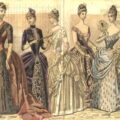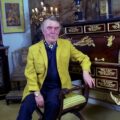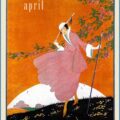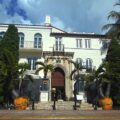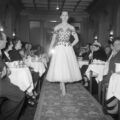1950s haute couture
July 1, 20221950s haute couture was lavish and inventive. The key designers included Christian Dior, Cristobel Balenciaga, Coco Chanel and Jaques Fath in Paris, Charles Creed, Norman Hartnell, Hardy Amies and Bianca Mosca in Britain. Several of them introduced ready to wear during this decade.
1950s haute couture in Paris
By the 1950s, Paris had resumed its mantle as the haute couture fashion mecca. There were fifty-four registered haute couture houses in Paris in 1956. Fifty-four designers might not seem like a lot, but a registered haute couturier in France was the biggest in the business, the emperors and empresses of fashion. Most had a staff of hundreds. The coveted membership of la Chambre Syndicale de la Haute Couture had strict demands such as a requirement to show 200 new designs each season. With four seasons in the fashion calendar it was a costly business. There were many smaller but no less wonderful designers in Paris. There were also dressmakers who would make a great copy or version of the designer garment a woman coveted but couldn’t afford, and then all the milliners, shoe makers, glove makers and producers of umbrellas to go with each outfit.
Christian Dior

1950s haute couture. Christian Dior gown. Image via Pinterest.
Christian Dior was awarded the Neiman Marcus Fashion Award in Dallas in 1947 for recognising exactly this, and also for being a business-minded, publicity hungry type of person whose influence was global. Each season’s star silhouette was different. The H Line, Zig-Zag, H-Line and Tulip were eagerly anticipated in their turn and breathlessly reported on. Each needed its accessories. Dior licensed his name to corsets, petticoats, bras and, of course, perfumes. There were protests in Paris and America about this new, constricting turn of fashion in 1950s haute couture and its need for all these bits and pieces. America’s “Little Below the Knee Club” had 3,000 members. But the fashion industry recognised that the more women bought, the better, and vigorously promoted the designer.
Coco Chanel

Coco Chanel dresses a model in the 1950s. Image via Lifestyle Asia.
Chanel had hidden under a rock during the war. More precisely, she closed her couture house and four boutiques and waited it out with her Nazi officer lover. She peeked out only to tell the Nazis that the majority shareholders of her perfume were Jewish. She hoped that their business would be seized and turned over to her. Fortunately they had anticipated this, and signed it over to a Christian man for the duration. It was returned to them afterwards.
When she reopened her salon in 1954, her first collection was a flop. It was exactly the same as her last, pre-war collection. It ignored all the structuring and playing with silhouettes that had gone on. However, her next 1950s haute couture collection, though still essentially the same, felt right. Perhaps because of the negative press about the dictates of the New Look, her boxy cardigan jackets felt like an unfussy antidote. Her popularity continued strong throughout the 1950s.
1950s Haute Couture in England
In England, the number of 1950s haute couture designers was much smaller. It always had been, though. 8- 12 was the usual figure in any given year. The official union in the UK was called the Incorporated Society of London Fashion Designers (IncSoc). It worked with the Chambre Syndicale over in Paris, though it had different rules. Together, they co-ordinated dates for collections to be shown, so that they didn’t overlap.
The practice of the presentation of debutantes at court had resumed after the war in 1947, and for this, and the balls during “The Season” the young women and their mothers needed couture gowns. This helped the industry. What really got it going was the Queen’s coronation in 1953. For this there were so many events needing formal gowns that the members of the IncSoc were kept extremely busy.
A true fashionista would go to Paris for her ballgowns. But the patriotic were well-catered for, and British designers were particularly good at tailored suits for the town and country, made from wool fabric made in England or, for tweed, Scotland.
1950s Haute Couture – Hardy Amies
Hardy Amies had set up business under his own name in 1945. He wasn’t a trained designer, but had a sharp eye for what fashionable people wore, and with a team around him could create beautiful and desirable clothes that were of the moment.
In 1950 he met Princess Elizabeth for the first time. Because she was also not super-fashionable, but needed to look correct and also of the moment, they clicked really well. He became a regular visitor to the palace with his team. In 1955 he was given a royal warrant.
1950s Haute Couture – Norman Hartnell

Queen Elizabeth’s coronation gown and sketch. Image via Peachtree Methodist Church.
Norman Hartnell had been the designer for Princess Elizabeth’s wedding gown in 1947. He was a real royal favourite. He also designed her coronation robe in 1953.
“My mind was teeming with heraldic and floral ideas. I thought of lilies, roses, marguerites and golden corn; I thought of altar cloths and sacred vestments; I thought of the sky, the earth, the sun, the moon, the stars and everything heavenly that might be embroidered upon a dress destined to be historic.
Altogether, I created nine differing designs which began in almost severe simplicity and proceeded towards elaboration.” he wrote, in his autobiography. In the end, the Queen and he decided on a dress embroidered with all the floral emblems of England, Scotland and Wales and the Commonwealth countries, in white silk with gold beading. He was particularly depressed that palace officials insisted he use a leek, not a pretty daffodil as he wanted, for Wales. But in the end he liked the design he came up with.
This commission meant that many other attendees of the coronation came to him for their frocks, too. His haute couture workshop in the 1950s was kept extremely busy with court dressing.



